#The Rossettis: In Relation
Explore tagged Tumblr posts
Text
youtube
Last summer, I had the absolute privilege of discussing the elixir of feminism, Irish mythology, and Rossettian aesthetics that make up Katharine Tynan's poetic retelling of Tóraíocht Dhiarmada agus Ghráinne at the Tate Britain. A highlight of 2023!
#I really will yap about Diarmuid and Gráinne forever#irish mythology#the pursuit of Diarmuid and Gráinne#tóraíocht#tóraíocht dhiarmada agus ghráinne#Tate Britain#Katharine Tynan#Irish Revival#Celtic Revival#Rossetti#pre raphaelite#dante gabriel rossetti#The Rossettis: In Relation#The Rossettis: Radical Romantics#Youtube
0 notes
Text
Part 3 of PHOTOGRAPHS OF THE ROMANTICS, A TUMBLR HISTORY EXHIBIT: photos i've collected of people related to the english writers of the romantic period and/or who were part of the byron-shelley circle.
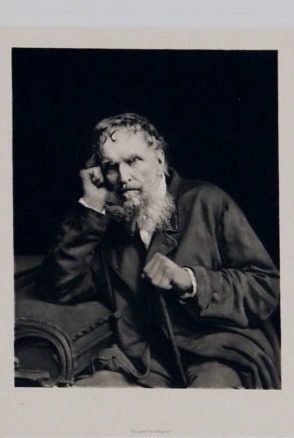

Edward John Trelawny (above: a photo of him as an elder compared to a portrait of him as a young man). A key member of the circle, celebrity/adventurer/writer, friend and biographer of Byron and Shelley. Outlived everyone. Proposed to both Mary Shelley and Claire Clairmont and remained in touch with them their whole lives. Really interesting person but also a chronic liar, making it difficult to tell which parts of his life stories are fact or fiction. He is buried next to Shelley (who is buried next to Keats); Trelawny bought the cemetery plot when Shelley died decades prior and later offered it to Mary Shelley who declined it. The last two portraits below were done by Joseph Severn, the artist who was friends with Keats, did most of his portraits, & took care of him as he was dying in Rome. I don't think Trelawny ever met Keats.

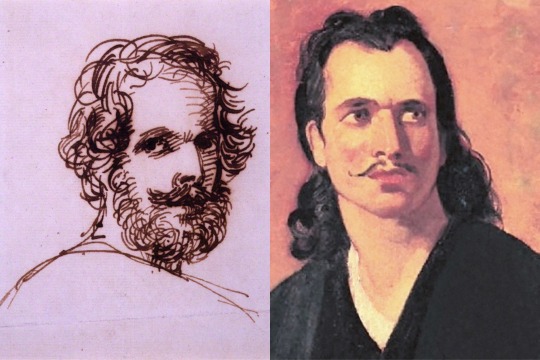
Jane Williams Hogg (née Cleveland). She was married to an abusive man named John Edward Johnson who she left for Edward Ellecker Williams, who was the father of her first two children and a friend of Percy Bysshe Shelley's cousin Thomas Medwin. The family then lived in the same household with the Shelley family (Mary, Percy, and their children) in Italy. Percy dedicated some of his last poems to Jane. After Percy and Edward died together in a boating accident she lived with Mary before partnering with Shelley's best friend from college Thomas Jefferson Hogg who she had two children with.
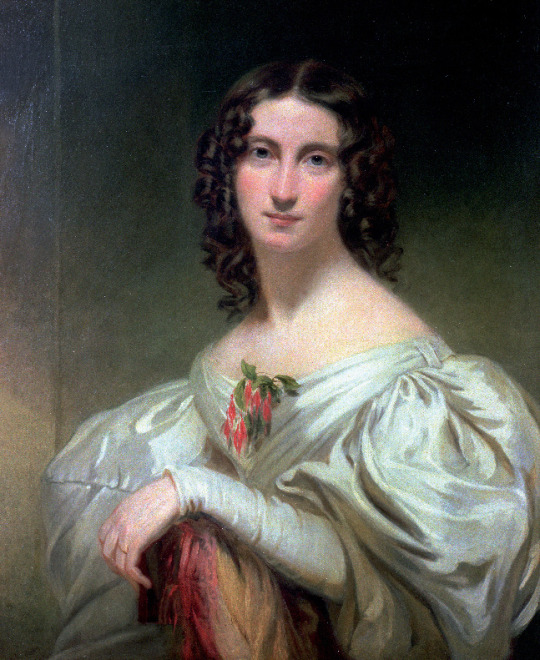
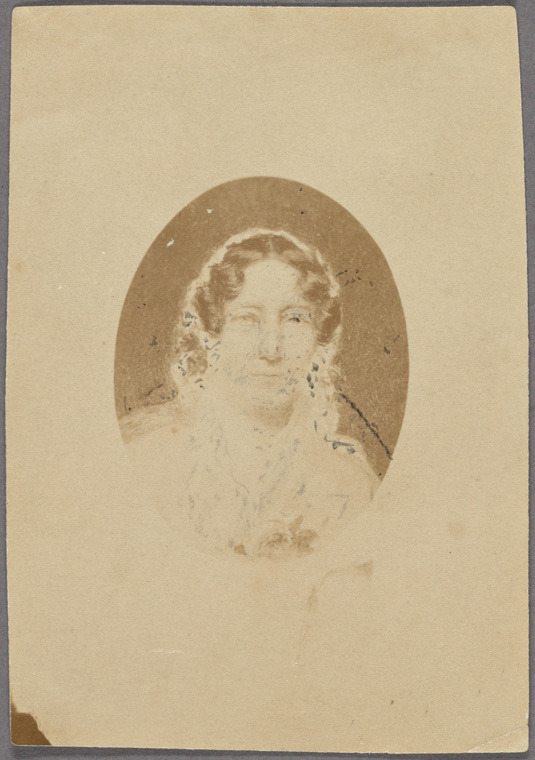
I think the similarity between her younger portrait (1822, age 24) & her photograph (date unknown, but she died in 1884 & seems like she could be in her 80s in the photo) are very striking; you can clearly see the nose, eyes, hair, and mouth are exactly the same, only older.
She also knew George Eliot and William Michael Rossetti; I mentioned the Rossettis in my last post. I wonder if she ever discussed Shelley's connection to John Polidori with them; I don't believe she ever met John Polidori, but maybe the Shelleys would have mentioned him to her.
Thomas Medwin, another key player of the Shelley-Byron circle in Italy. Cousin of Percy Bysshe Shelley and friend/biographer of Shelley and Byron.
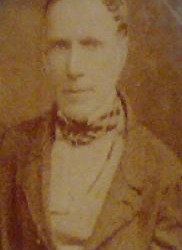
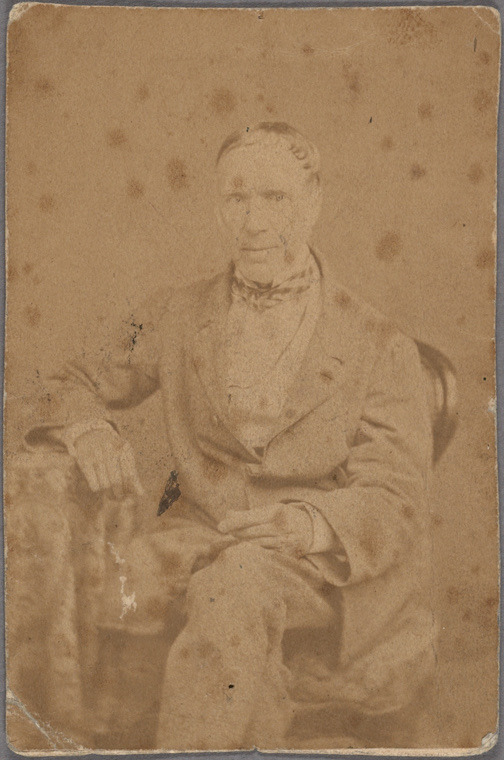
Wilhelm Charles Gaulis Clairmont, the nephew of Clara Mary Jane Clairmont aka Claire Clairmont. Wilhelm was the son of her half-brother Charles Gaulis Clairmont.

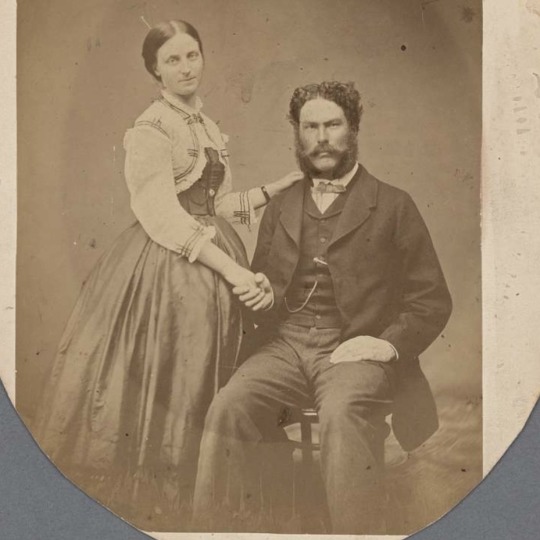
#photographs of the romantics#literature#english literature#romanticism#lord byron#percy shelley#percy bysshe shelley#thomas medwin#jane williams hogg#thomas jefferson hogg#shelley#byron#mary shelley#mary godwin shelley#claire clairmont#edward trelawny#victorian#romantic#english romanticism#the romantics#romantic poets#victorian era#1800s photography#1800s#history#english poetry#poetry#romantics#shelley-byron circle
64 notes
·
View notes
Text

The Fetch [Irish/Scottish folklore]
Imagine unexpectedly meeting a dear friend, who seemingly crossed paths with you by pure coincidence. But something’s wrong: the friend is acting weird and you get the feeling that you’re not talking to someone you’ve known for a long time, but rather an exact copy of that person. This, in old Irish folklore, is the Fetch: an enigmatic being that copies a living person down to the smallest details.
While the Fetch was always regarded as an omen of sorts, John O’ Hanlon made an important addition in his 1870 book ‘Irish Folk Lore’: according to him, the person whose future the Fetch predicts is not the one who sees the omen. Instead, the creature will appear as an exact copy of someone and will then appear to a close friend of the one he copied. This will often be a strangely sudden and mysterious meeting. If this friend sees the Fetch in the morning, this will not affect him, but the person who was copied will live a long and prosperous life. If the friend sees the Fetch at night, the person who was copied will die soon, but the person who sees the apparition will not be affected either way.
According to Feats, belief in the Irish Fetch was also commonly found in Scotland. This claim might have been derived from a statement by O’Hanlon that the Fetch is related to a similar Scottish spirit.
Sources: Kinahan, F., 1983, Armchair Folklore: Yeats and the Textual Sources of “Fairy and Folk Tales of the Irish Peasantry”, Proceedings of the Royal Irish Academy, Section C: Archaeology, Celtic Studies, History, Linguistics, Literature, Vol. 83C, pp. 255-267. Yeats, W., 1993, Writings on Irish Folklore, Legend and Myth, Penguin UK, 496 pp. (this is a collection of Yeats’ writings from the late 19th and early 20th century.) (image source: ‘How They Met Themselves’, 1864 watercolor painting by Dante Rossetti. The painting is not meant to depict the Fetch spirit but I thought it fits well.)
164 notes
·
View notes
Text
Okay, time for MY headcanons about the YJs' taste in books
Shauna: Canonically likes Kurt Vonnegut. Perhaps other satirical novelists like Evelyn Waugh, Joseph Heller, and Bret Easton Ellis. Likeliest YJ character to have actually read and enjoyed Lord of the Flies, but took the wrong lessons from it. Reads lots of feminist nonfiction but little feminist fiction. Jackie: Not much of a reader. Naturally gravitates towards "airport"/"beach" novels but can be sold on somewhat meatier literature with aesthetic and genre qualities that are similar, like Daphne du Maurier's body of work and, in a pinch, Wuthering Heights. Lottie: I think she would like the kind of Asian Christian fiction that becomes popular-ish in the West. Silence, The Martyred, that sort of book. Genuinely enjoys paradigmatic "school study" novels like The Great Gatsby, East of Eden, and the like. Claims to have read more Dostoyevsky than she has, but has at least read White Nights and The Idiot. Unlike Nat, knows who Mishima Yukio is but refuses to read anything by him. Nat: Is a Hunter S. Thompson girlie. Unlike Lottie, has read at least one Mishima novel but doesn't know anything about him. Taissa: Mostly reads nonfiction related to her philosophical, political, and historical interests. Lots of Eric Foner, Lillian Faderman, W.E.B. Du Bois, law reviews, weirdo economists (affectionate) like Henry George and E.F. Schumacher, maybe some British commentators on land issues like William Cobbett, J.B. Priestley, and Oliver Rackham. Van: The only big "genre" reader. Has read a fair amount of Tolkien; was into Terry Brooks for a while; really enjoys feminist and lesbian fantasy and science fiction; felt betrayed about Marion Zimmer Bradley but, conversely, doesn't like Anne Rice nearly as much as... Misty: Likes Anne Rice more than Van does. Likes Anne Rice more than MOST people do. Canonically reads Nora Roberts. Would have a worrying amount of overlap in taste with a living, forty-three-year-old Jackie. Laura Lee: Was born to read the Locked Tomb books behind her parents' backs, heavily annotating all the Biblical quotes and paraphrases and having big feelings over Mercymorn and Cristabel. Unfortunately, was born too early for that, and did the equivalent with Brideshead Revisited instead. Was mortified when Shauna mixed up Laura Lee's copy of Brideshead with her own and almost brought it home with her one day. Enjoys Victorian poetry like Rossetti and Hopkins. Akilah: Really into the kind of older children's literature that is written in an erudite enough way that it is now read mostly by teenagers and adults, like L.M. Montgomery and Elizabeth Goudge. Mari: Born to read Otherside Picnic, forced to read the first Animorphs book over and over after stealing it from a younger relative eighteen hours before the crash.
27 notes
·
View notes
Text
Academy Awards for my 18th-21st Century English Literature class:
Poem that made me cry the most: Ode on a Grecian Urn by John Keats
Book that made me cry the most: Mrs. Dalloway by Virginia Woolf
Most delightful (and relatable) poem: Nutting by William Wordsworth
Poem that made me have the most gay feelings: Goblin Market by Christina Rossetti
Poem that traumatized me the most: Dulce Et Decorum Est by Wilfred Owen
Poem that made me go “heheheahah that’s fucked up” the most /pos: My Last Duchess by Robert Browning
Poem that most represented my semester: On Seeing the Elgin Marbles by John Keats
Poem that most made me want to irrationally kill someone: Tithonus: 46 minutes in the life of the Dawn by Alice Oswald
Poem that led me to read the most fanfiction about Lord Byron’s sexcapades: Darkness by Lord Byron
Poem that led me to learn that Percy Bysshe Shelley drowned at 29 while steering a boat very poorly after repeatedly almost drowning, being rescued, and refusing to ever learn to swim: Ozymandius by Percy Shelley
Most punchable character: Peter Walsh from Mrs. Dalloway. Stop stalking women with your pocket knife. What the fuck.
Least punchable character: Lucie Manette from A Tale of Two Cities
Character whose brain I would most like to study: Sula from Toni Morrison’s book, Sula.
Overall favorite book: A Tale of Two Cities by Charles Dickens
Overall favorite poem: Nutting by Wordsworth
#english literature#hamlet server folks have already seen this#but for posterity#john Keats#virginia woolf#william wordsworth#christina rossetti#Wilfred Owen#fun fact I spelled his name wrong for three months and no one corrected me#I am SO sorry#robert browning#alice oswald#lord Byron#percy bysshe shelley#toni morrison#Charles dickens#what I wouldn’t give to put all these people in a room together#18th-21st century authors & poets battle royale…#who would win?#I feel like I could place bets on who *wouldnt* win
9 notes
·
View notes
Text

A Sea Spell
Artist: Dante Gabriel Rossetti (British, 1828-1882)
Date: 1875-1877
Medium: Oil on canvas
Collection: Harvard Art Museums, Cambridge, Massachusetts, United States
Description
A Sea-Spell is an oil painting of 1877 and an accompanying sonnet of 1869 by the English artist Dante Gabriel Rossetti, depicting a siren playing an instrument to lure sailors. It is now in the Harvard Art Museums in Cambridge, Massachusetts.
The painting depicts a siren in human form playing a musical instrument "in a thoughtful reverie", surrounded by apples, apple blossoms, and a seagull. The instrument being played has been described as a harp and as "somewhat related to the psaltery"; according to an analysis published in the journal Music in Art, it is an unusually short Japanese koto, a traditional 13-stringed zither-like instrument.
The artist's brother William Michael Rossetti described the subject as "a Siren, or Sea-Fairy, whose lute summons a sea-bird to listen, and whose song will prove fatal to some fascinated mariner".
Poem
Rossetti wrote a sonnet in 1869 as a "double" of the painting completed years later, as he did for several other works in the same period. The text of the poem is as follows:
Her lute hangs shadowed in the apple-tree, While flashing fingers weave the sweet-strung spell Between its chords; and as the wild notes swell, The sea-bird for those branches leaves the sea. But to what sound her listening ear stoops she? What netherworld gulf-whispers doth she hear, In answering echoes from what planisphere, Along the wind, along the estuary? She sinks into her spell: and when full soon Her lips move and she soars into her song, What creatures of the midmost main shall throng In furrowed surf-clouds to the summoning rune: Till he, the fated mariner, hears her cry, And up her rock, bare-breasted, comes to die?
#oil painting#19th century art#dante gabriel rossetti#english painter#poem#music#woman#flowers#music instrument#apple blossoms#seagull#pre raphaelite
19 notes
·
View notes
Text
🔮CIRCE, MEDEA and THE FEMME FATALE🔮
In the collective imagination, we think of Medea and Circe as free spirited witches, women who didn´t obbey men, sorceresses with enough power to do what they wanted. And most important of all, they weren´t afraid to use that power.
When we think of them, we usually have these portraits in our minds:
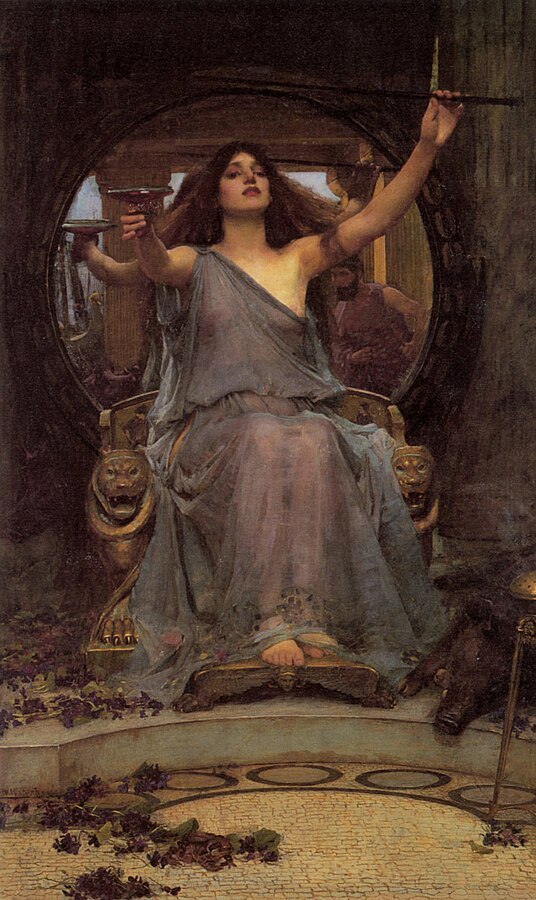
Circe Offering the Cup to Ulysses (1891), John William Waterhouse.
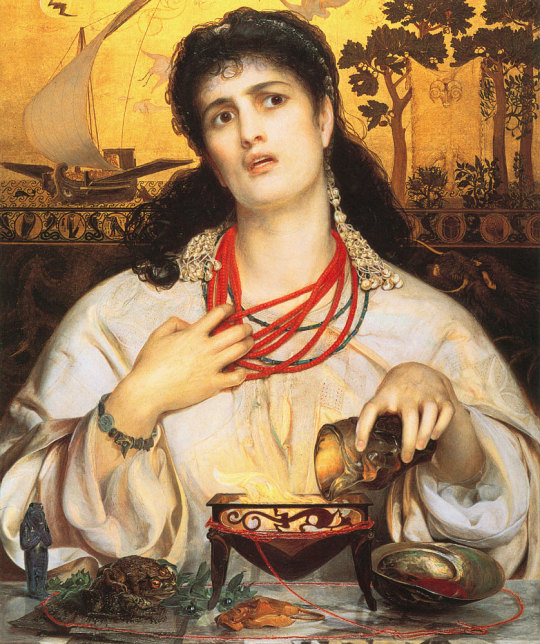
Medea (1866-1868), Frederick Sandys.
The resurgence in popularity of Circe and Medea in the 19th century was closely related to the creation of a new archetype for women, the femme fatale. Based on the biblical figure of Lilith, Adam's first wife, the femme fatale was a dangerous, sexually liberated woman.
She was everything a real woman of her time couldn't be or do.
Artists from the Victorian era, like Dante Gabriel Rosseti, John Waterhouse and Valentine Cameron Prinseps, took characters from Antiquity and attributed the features of the femme fatale to them.

Lady Lilith (1866-1868), Dante Gabriel Rossetti.
In one of the versions of the painting above, there was a poem attached which I think really captures the essence of the femme fatale:
Beware of her fair hair, for she excells
All women in the magic of her locks
And when she twines them round a young man's neck
She will not ever set him free again.
Finally, we can see another depiction of Medea, this time by a German painter called Anselm Feuerbach :

Medea (1873), Anselm Frederick Feuerbach.
#art history#art#artwork#ancient history#victorian era#victorian#medea#circe#women#women history#hellenic deities#femme fatale#19th century#pre raphaelite#pre raphaelism#john william waterhouse#frederick sandys#dante gabriel rossetti#anselm feuerbach#sorceress#fine art#1860s art#1890s art#1870s art
23 notes
·
View notes
Note
Though Italian secret societies in England trying to strike England in particular is more of the author being weird about Italians
Collins definitely is weird about Italians (/foreigners more generally), but I don't think they're supposed to be striking England in particular? It's still a bit murky in relation to Fosco, but Pesca is there to "wait" because Italy got too hot for him. Apparently he might have been based on Gabriele Rossetti, real-life founder of the Carbonari, who was exiled to England.
7 notes
·
View notes
Text
Lilith as "the mother of all woman?" | Demystifying.
Note: this post is not intended to encourage or discourage the worship of Lilith, but rather to bring reflections based on historical and mythological analyses about themes that have been and continue to be extremely distorted.

(att by Murat Gül)
This is a subject that has sparked extensive discussions in occultism circle for a long time. Certainly, Lilith strongly embodies the definition of Woman Contrary/Opponent to the reigning Abrahamic patriarchal system. But when we talk about Lilith, we talk about a history with deep roots.
We can't say that the image of Lilith was derived from a single entity, but from from different ancient concepts, which I will branch out into a few different lines. Commonly found in Jewish myths (midrash and folklore) the origins of Lilith is dated as a Sumerian Succubus. Then the image of Lilith was presented on the Alphabet of Ben Sirah (a compilation of two lists of proverbs, 22 in Jewish Babylonian Aramaic and 22 in Medieval Hebrew), seen as a demoness instead of the "first Eve".
Look at the history:
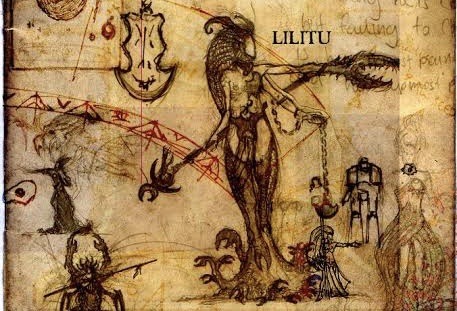
(unknown artist)
1- Lilitu in Mesopotamia:
The Semitic root "LYL" translates to "Nocturnal". Derivatives also include "Lalu": the wanderer; "Lulu": Wanton/Luxurious.
Lilitu was a formless adjective used in Mesopotamia to refer to female entities of the night. She was designated as the Queen of the Lilu, vampiric entities that invaded men's erotic dreams to steal their semen. Thus giving birth to the "Lilins" = man-devouring abominations.
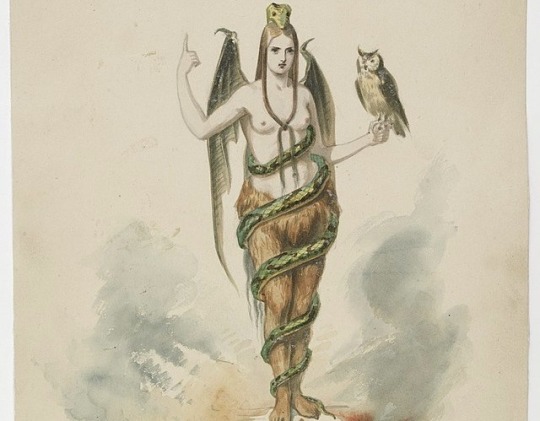
(art by: P. Lormier 1848)
2- Ardat Lilith
"Ardat" is a term originally related to "prostitutes" and also "impure women". In Mesopotamia, Ardat Lili becomes a Semi-Goddess. Thirsty for blood, sinful and associated with diseases and darkness. Ardat Lilith was known as "unable to produce milk" and "the woman without husbands", "reaper of men".
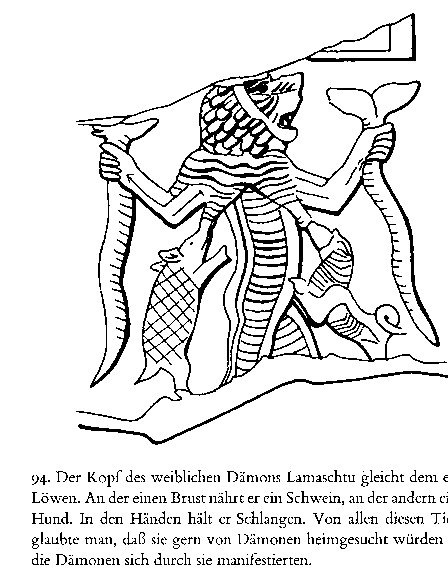
3- Lamashtu
Another entity rooted in Lilith's foundations, she was the daughter of the Gods of the Heavens. Often depicted with grotesque figures and portrayed with a lion's head, donkey's body, bird's talons, and dry breasts.
Feared by pregnant women, she was known to invade family homes and bind newborns, or even devour them. Lamasthu was also recognised for her abilities to fly and her knowledge of natural elements.
Pazuzu was often invoked as a protector against Lamasthu's forces, to prevent her from her bloody deeds.
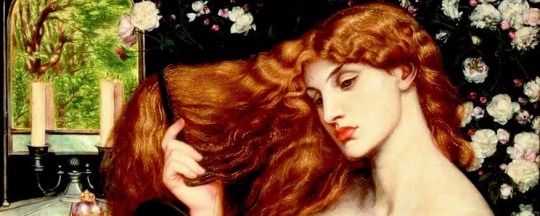
(Art by Dante Gabriel Rossetti, Lady Lilith (1866-1868), Delaware Art Museum)
Frequent confusion:
Confusion between the concepts of Lilith and Ishtar is frequent, where Lilith is sometimes mistakenly equated with a kind of "dark aspect of Ishtar." While Ishtar is revered as the goddess of procreation, fertility, love, and sexuality, some modern interpretations blur these deities, attributing to Lilith - a Vampiric entity, qualities with erroneous concepts such as fertility in a very humane concept: "mother goddess of women," etc. Well, she is indeed, the mother of aberrations and demons in certain mythological and religious traditions, especially in Jewish folklore and Kabbalistic teachings.
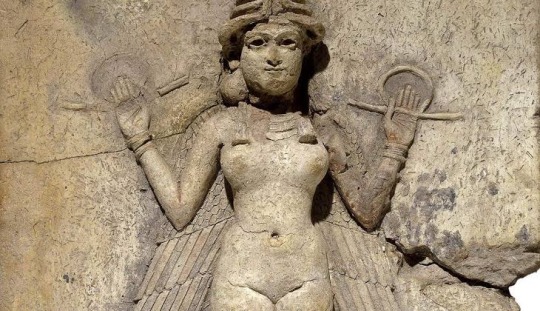
(Old Babylonian, 1800-1750 BC. From southern Iraq. (British Museum, London)
The mythological figure of Ishtar dates back to ancient Mesopotamia, where she was worshipped by cultures such as the Sumerians, Akkadians, and Babylonians. Her divinity encompassed both positive and negative aspects of existence, reflecting her influence over fertility, love, war, and sexuality.
The confusion between Lilith and Ishtar can be partially attributed to the attempt to correlate these deities, often due to their association with femininity and their duality of characteristics. However, it is crucial to emphasize that these contemporary correlations should be approached with caution, recognizing the intrinsic nuances of the specific mythologies from which they emerge.
The challenge, furthermore, lies in the diversity of perspectives regarding Lilith. While some interpretations categorize her as a negative polarity and Demonic figure, others see her as a symbol of female autonomy and resistance. These differences in interpretation can be attributed to the various cultural and religious traditions that have influenced the evolution of Lilith's image over time.
This text aims to clarify, in an objective manner, the underlying complexity of the figure of Lilith, recognizing the multiplicity of historical and contemporary interpretations that have shaped her representation. The approach seeks to avoid oversimplifications and provide a more comprehensive and informed understanding of Lilith's role in the mythologies and cultures in which she is embedded.
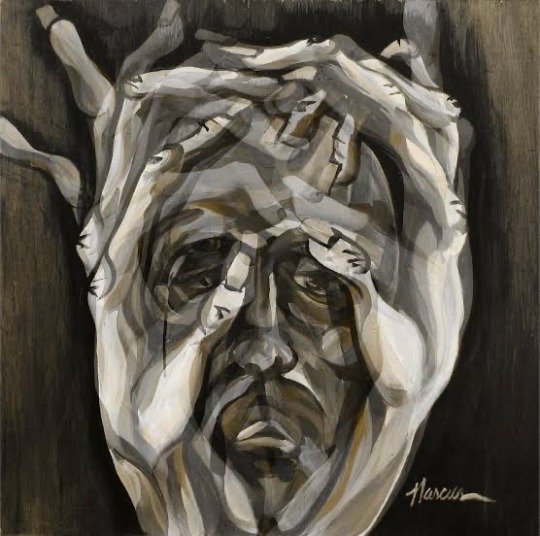
(art by: Marcus Ortega)
I often perceive levels of resentment within the occultism community when this type of content is brought into the historical/ academic sphere, leading to rejection and sometimes unpleasant discussions.
It is of utmost importance, however, to emphasize that bringing content grounded in history about certain entities/goddesses rooted in something many of us oppose - Abrahamic influence and their demiurgic false god; does not imply support or endorsement of this kind of belief.
Dealing with complex subjects requires a certain level of maturity, and relying solely on “voices in one's head" leads us into the realm of fallacies.
Lilith and feminism?
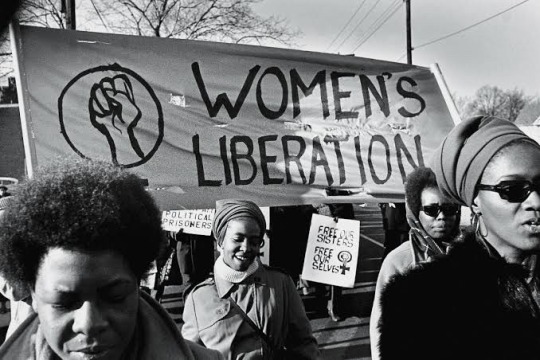
During the fight for freedom and gender roles during the 60s, Lilith became a "feminist" icon representing rebellion and liberation.
The feminist movement saw interested parties in society take a second look at Lilith’s story. Claiming that she was unfairly demonised by abrahamic creeds and Sumerian mythology. Especially for her refusal to submit to Adam (Jewish Mythology). I see indeed a kind of beauty and strength in the philosophical concept.
Note: Feminism = equity and equality; not supremacy. And Lilith...wel, at this point you should know.
But were it comes the part were everything becomes a big mess:
With the expansion of "religions" and whitewashed beliefs rooted in New Age movements, many have lost their minds, and consequently, some leaven of logical reasoning. And I like to emphasize how the pursuit of knowledge becomes crucial in ancestral practices and historical concepts.
Conclusion?
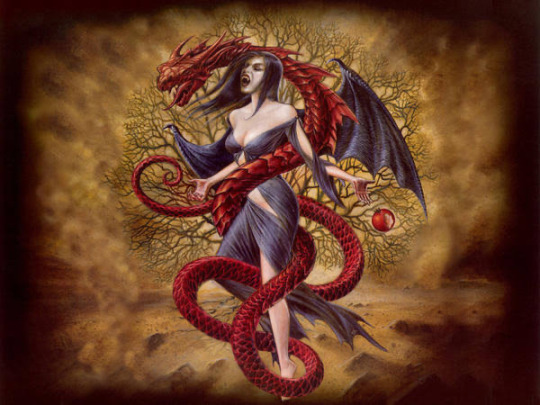
(art by: Lord-Scandamour)
Through historical and mythological analyses, it is highly inconceivable to correlate an Lilith as our mother; or a entity devoid of a humane concepts of empathy with the human race, neither human broken concept of love understood by us. Likewise, attributing her as a mother goddess or as I frequently see some peoples affirming they're: "Lilith's daughter" makes no sense (unless you are a demon who climbed the "infernal" mountains to reach the Earth - but let's set aside these schizophrenic concepts). It is important to face reality, especially when dealing with mythological/historical/ancestral cults. Without any lens that embrace interpretations based in fantasy.
Lilith is, indeed, a Vampiric Demon and have always been, she does represents the Dark Feminine, and various aspects of the feminine and rebellion. There isn't a universally standardised way or form of worshiping Lilith, and I am not claiming so. I carry a lot of respect with this force and strong energy, and just find necessary to spread knowledge and informations.
Isheth Zenunim Taninsam Ama Lilith, Liftoach Kilt
<Copyrights>
List of contents for a very diverse research (some still on my readings list/wishlist):
The Alphabet of Ben Sira": This medieval Hebrew text is a primary source for the Lilith myth. It describes Lilith as the first wife of Adam and the mother of demons.
"The Encyclopedia of Demons and Demonology" by Rosemary Ellen Guiley: This book provides an overview of various demons and mythological figures, including Lilith. It may offer insights into Lilith's role as a mother of demons.
"Lilith, Queen of the Night" by Steve Savedow: This book delves into the various aspects of Lilith in mythology and folklore, including her association with demons.
"The Lilith Monographs" by B. Morlan: This series of monographs explores Lilith in depth, and some of them touch upon her role as a mother of demons.
“Devils and Evil Spirits of Babilonia Vol. I” Reginald Campbell Thompson
Lilith: Dark Feminine Archetype" by Desda Zuckerman: Desda Zuckerman explores Lilith as a dark feminine archetype in this book, drawing on both historical and esoteric perspectives.
"Lilith: Healing the Wild" by Tom Jacobs: This book combines mythology, astrology, and psychological insights to explore Lilith and her role in personal and collective healing
The Book of Lilith" by Barbara Black Koltuv: Koltuv provides an in-depth exploration of Lilith from a Jungian psychological perspective, incorporating mythology, dreams, and symbolism.
The Satanic Bible" by Anton LaVey: Anton LaVey, the founder of the Church of Satan, includes references to Lilith in "The Satanic Bible." In the book, she is mentioned as a symbol of female independence and strength. However, it's crucial to understand that LaVeyan Satanism is atheistic and symbolic, viewing Satan as a symbol of individualism and rebellion rather than a deity.
"Lilith: Goddess of Sitra Ahra" by Daemon Barzai: This book explores Lilith within the context of Sitra Ahra, which is considered the "Other Side" or the Qliphoth in some forms of Western occultism. The Qliphoth is a concept within Kabbalistic mysticism, and some practitioners of the Left-Hand Path incorporate Lilith into their esoteric practices.
11 notes
·
View notes
Text

Had the nicest day today.
Met a friend for coffee and massive scones - I had wholemeal apple and cinnamon and a REALLY good mocha - and sat in the massive window of the cafe on the prom, watching the weather and the mist and the sea and the seals. It’s been such a - quite frankly - shitty Summer and it was so nice to just be silly and serious and spend time with someone I’m not related to.
Bopped round the charity shops in town, picked up a load of books - including one from my wish list - and spent £2 on them. Treated myself to super dark chocolate with raspberries in.
Came home and spent a few hours playing Destiny with Alfie, eating lunchables, making up stupid songs about PVP and just generally being silly. And introduced him to the poetry of Christina Rossetti.
Early dinner. Dozed for a while. Snacking on sour patch kids and watching Orphan Black. Feeling comfortable in my skin for once.
Oh, and when I was cooking dinner there was an ENORMOUS chip.

5 notes
·
View notes
Text
Explore my bookshelf!
Tagged by @theghostinthemargins, thank you <3
An estimate of how many physical books I own: probably around 500-750, but the bulk of my "collection" is at my parent's house. I buy 90% of my books second hand.
Favorite author: Tolkien is the obvious one. Besides him, I always enjoy N.K. Jemisin, Octavia Butler, Sayaka Murata, Natsuo Kirino, Angela Carter, Christina Rossetti, Banana Yoshimoto and others.
A popular book I've never read and never intend to read: The Love Hypothesis and related books... I don't think they're the death of literature or anything, but I have no interest in them.
A popular book I thought was just meh: Megan Nolan's Acts of Desperation was good but not great.
Longest book I own: The 2016 Washburn edition of The Tale of Genji comes out at 1320 pages, so I believe it wins this one.
Longest series I own all the books to: The Histories of Middle Earth, of which I own all twelve books plus the index.
Prettiest book I own: Angela Carter's Book of Fairy Tales. Look at it! The woodblock prints by the author included in Amy Jeff's Storyland and Wild are also really beautiful.
A book or series I wish more people knew about: I need the tumblr cannibalism enjoyers to get into Sayaka Murata's Earthlings and Life Ceremony. Truly wrenching and thought-provoking gore and darkness here.
Book I'm reading now: I'm in a bit of a reading slump at the moment, but I picked up Han Kang's The White Book and Flaubert's Three Tales from the library to hopefully bring me out of it.
Book that's been on my TBR list for a while but I still haven't got around to it: Our Wives Under the Sea by Julia Armfield has been on my shelf for a while despite all indicators suggesting I'd like it. I'm hoping I'll read more when I start commuting to work again.
Do you have any books in a language other than English: A couple of poetry and short story collections in both Japanese/Korean and English, otherwise no.
Paperback, hardcover, or ebook? Paperbacks because I like flicking through them and they're easier to store, hardbacks because pretty, ebooks because I can read them on my phone wherever.
no pressure tags for @imakemywings @meadowlarkx @polutrope @jouissants @aipilosse @matrose @mirillel and @welcomingdisaster <3
17 notes
·
View notes
Text
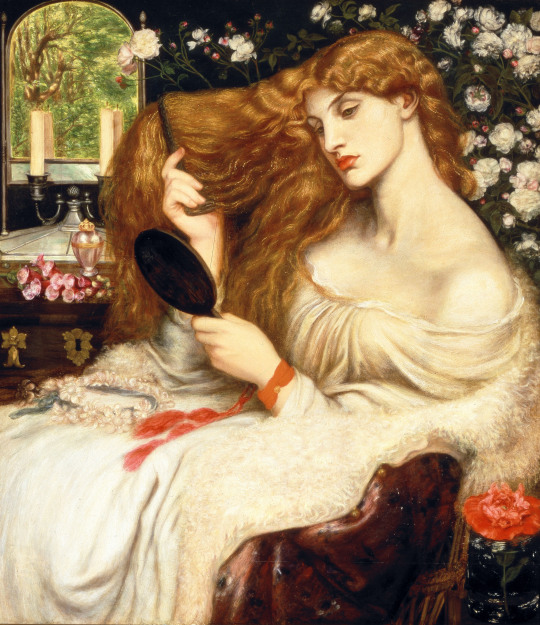

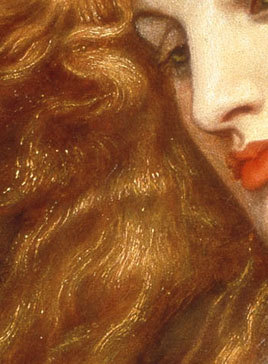
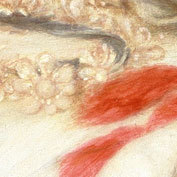
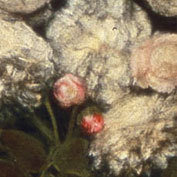
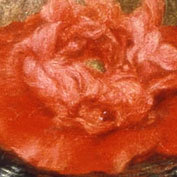
Dante Gabriel Rossetti’s “Lady Lilith.” This painting was supposed to represent the body’s beauty, as opposed to his painting “Sybilla Palmifera,” representing the soul’s beauty. From the link:
DGR's remarks to his friend Hake (21 April 1870) are fundamental: “The picture is called Lady Lilith by rights (only I thought this would present a difficulty in print without paint to explain it,) and represents a ‘Modern Lilith’ combing out her abundant golden hair and gazing on herself in the glass with that self-absorption by whose strange fascination such natures draw others within their own circle.” (Fredeman, Correspondence 70.110)
Allen's excellent study of DGR's treatment of the Lilith theme draws attention to the importance of the hair iconography—in particular to the relation DGR draws between hair as a sign of erotic power and as a figure of entrapment.
DGR poses Lilith in a manner strongly reminiscent of his 1870 picture Woman with a Fan , a portrait of Fanny Cornforth.
The floral paraphernalia include a semi-coronal of white roses, which appear to signify cold sensuous love (according to legend, roses gained their red coloring only when Eve was created, at which point the rose blushed at the sight of her beauty); a crown of poppies on Lilith's lap (signifying sleep and forgetfulness); and a spray of foxglove on the bureau (signifying insincerity).
... Allen calls attention to the contemporary relation between the figure of the femme fatale and the Women's Emancipation Movement in England. More specifically, she notes that among DGR's papers was a letter to the editor of the Athenaeum dated November 1869 in which the author, Ponsonby A. Lyons, makes the following observation: “Lilith, about whom you ask for information, was the first strong-minded woman and the original advocate of women's rights” (WMR, Rossetti Papers 1862 to 1870, 483).
31 notes
·
View notes
Text
Part 2 of PHOTOGRAPHS OF THE ROMANTICS, A TUMBLR HISTORY EXHIBIT: photos i've collected of people related to the english writers of the romantic period and/or who were part of the byron-shelley circle.

Frances Mary Lavinia Rossetti (née Polidori), the younger sister of John William Polidori (pictured next to her above), author/poet/doctor best known for his work The Vampyre, written while working as the personal physician of Lord Byron in 1816 and inspired by Byron's story Augustus Darvell. Frances was also the wife of Gabriele Rossetti and mother of famous artists/writers Dante Gabriel Rossetti, Christina Georgina Rossetti, and other children.
Photographs of the Rossetti family taken by writer Lewis Carroll(!):




Frances Rossetti (née Polidori) in the white headwear posing with daughter Christina Georgina Rossetti (poet of Goblin Market):

The granddaughter of Sir Walter Scott, Charlotte Harriet Jane Hope née Lockhart (1827-1858). Walter Scott is one of the most famous Scottish writers, the best-selling novelist of the Romantic era, and a friend and inspiration to Lord Byron.

Her only child, Mary Monica Maxwell-Scott (2 October 1852 – 15 March 1920) who was also a novelist like Scott:

#photographs of the romantics#walter scott#john polidori#christina rossetti#dante gabriel rossetti#frances rossetti#the vampyre#lord byron#percy shelley#percy bysshe shelley#the romantics#romanticism#romantic literature#english romanticism#victorian#romantic era#victorian era#1800s photography#1800s#history#poetry#romantic poets#english lit#literature#english literature#john william polidori
34 notes
·
View notes
Text
lady-merian: What’s In the Forests of the Night?
So, I think the series is technically called The Goblin Wars, but it’s a trilogy inspired by William Blake’s The Tyger, Christiana Rossetti’s Goblin Market (I think this one is right), and the Irish Sidhe. It’s been a while, so I’m going to call on @lover-of-the-starkindler to correct any mistakes, but the general gist is this (with the long, spoilerly part under the cut):
Our protagonist is a high school girl named Tegan Wylltson, who has a pretty normal life: she goes to school with her best friend Abby, lives with her parents and younger brother Aiden, and spends her free time volunteering with the vet at a local zoo. And then her parents decide to answer her grandmother’s request to give a teenage distant relation a new chance in America. Finn Mac Cumhaill may be handsome but he’s also strange and full of trouble from the moment he shows up on their doorstep. And before the week is out, a strange creature has appeared in the Wylltson’s basement, Finn has fled, and Tegan’s mother has caught a sudden sickness and died.
Intriguing start, right???
Obviously, Tegan is reeling from her mother’s death, as are her father and brother - but Aiden is the one who keeps talking about seeing sick, decaying cats around. This eventually results in social services getting involved, and basically some mandated therapy sessions for Aiden in lieu of him being removed from their home (there’s also some question about the father’s fitness, I guess? At some point, he seems to be losing his memory and grip on reality, but I can’t remember the exact sequence). The therapist is very calm and doesn’t seem to see any harm in Aiden’s stories. In addition, there’s Abby, who seems to be straying a line between too much creativity (talking about seeing goblins and other strange sights) and rebelling against her Italian Catholic upbringing (some odd theological comments, including wondering why God couldn’t be a woman), with a dash of boy-craziness (crushing on a gorgeous guy that she keeps seeing around).
Tegan is just trying to keep things together and is succeeding pretty well - up until she meets Abby’s crush: he’s not just gorgeous, he’s very very wrong somehow. And then Finn shows up again, and there are some fights and fleeing for their lives and so on and so forth because - you guessed it - the crush is a Sidhe, Aiden is really seeing goblins, and Tegan’s mother didn’t die from a normal, if rogue, human disease.
At any rate, Tegan, Finn, and Aiden end up in the current stage of an ongoing battle between the Sidhe/Goblins and the branch of Irish Travelers Finn and Tegan’s family belong to. Finn was raised to fight the Sidhe/Goblins (I think he was sent to America partially because they were too hot on his trail and he wasn’t that good at fighting yet???), and Tegan’s mother had delayed her fate by moving to America, getting married, and settling down. There’s a lot of fighting, travels into the fae world, and general high stakes - pretty good stuff.
ALSO, we get Tegan and Finn being interested in each other, Tegan’s dad going, “Well, I don’t necessarily have an issue with you, Finn, but I’m not letting Tegan’s plans of vet med school get sidetracked at this stage because of you”, and Finn going, “I respect that and while, yes, I will be around a lot, I will continue to get to know Tegan and try very hard to keep it just friendly.” And Tegan and Finn mostly make that work??? I dunno, it’s just a VERY rare tact to take, and I really appreciated it. :)
But now, having hit the high points, we hit the low points, AKA the third book. I honestly don’t even remember how everything gets resolved, but I’m pretty sure the plot doesn’t deliver. The climax is a big battle happening in our world that Finn, Tegan, and Aiden have to escape from to defeat the Sidhe in the fae world, and Teagan’s dad is being the distraction (AKA sacrifice) for this escape. But he’s not alone, because, what’s this coming out of left field and smashing everything?? It’s the female therapist who is also supposed to be God??? And things suddenly go from ‘Abby’s theological comments are just a reflection of her different take on things’ to ‘Abby was 100% right, never mind the fact it doesn’t make any plot sense much less theological sense about WHY the therapist and everything else!!!’. :/
SO.
Yeah.
There are some things I can handle and ignore and work around, but not that.
At any rate, I think most people make it out alive, but not everyone. I thought Teagan’s dad died, but that doesn’t really make sense because the therapist was there to back him up (again ????? why doesn’t everything just suddenly get fixed if God is right there??? Not to mention, why a human body???), so I think he survives. Abby survives, I think, as do the primary three - and they rescue Teagan’s aunt, who’s been trapped in the fae world for years, and her goblin quasi-love interest, I think???
So, in conclusion: there was SO MUCH good potential and, even with some flaws/disagreements (didn’t care for the evolutionary bend on Teagan’s work with primates at the zoo), so much going for it in the first two books and then there was an irreparable direction taken for me. Very sad and frustrating. :(
#Okay this got long but think I'm done XD#Lady-Merian#lover-of-the-starkindler#Edit: for anyone just looking at the tags this is not a book/series recommendation unfortunately but a discussion of why it failed for me
11 notes
·
View notes
Text
To Rossetti art was the expression of the artist’s more peculiar emotions; and this he found most intense and complete in isolated works of art such as pictures. But Morris always saw in a work of art the relation between the artist and his public; and it was for him a social business that could not be well practiced except in a healthy society. This view of art was not a mere theory for him; it came to him through his own experience and he made a theory of it because his reason confirmed his instinct. He began by loving all Gothic art because of its noble submission to architecture; and he could not feel the same love for the art of the Renaissance when it became independent of architecture. There was egotism in it that displeased him and which seemed to him, when he came to think about it, a symptom of all the egotistical heresies of the modern world. With all his passion for art he was not inclined to glorify the artist or to conceive of him as a superman producing masterpieces in his lonely pride. He thought of him rather as a workman who gave more than was asked of him from love of his work.
Arthur Clutton-Brock, William Morris Temporis
2 notes
·
View notes
Text
ok, museum thoughts blogging time:
Tate Britain:
echo lake peter doig: probably my favorite painting of the gallery. mysterious figures! eerie atmosphere! it’s such a good contrast of the dark greenery and dark blood red lake. and the lime-green leaves been completely absent in the reflection. the dude without a discernible face.
i’m desperate gillian wearing cbe hahahaha this is just a photo of a business man in a tight smile with dead eyes and a paper saying “im desperate” i hate that my life is just relating to fucking business men but here i am LMAO
peace - burial at sea JMW Turner ok so this guy was also obsessed with sea wrecks lmao. this one hit the most because it’s Such a sunny perfect day but it’s contrasted with the bleak black sails of a burning ship. anyway good shit. i see online that there’s corners of the painting I didn’t see because it was in an ostentatious frame im furious
ophelia sir john everett millais ok it’s Ophelia it was expected lol. but the vibe of this was actually great, personally, since i got there early and was like the only person there. the floorboards were also super creaky. the specific gallery was filled with a bunch of sad victorian women paintings. good atmosphere for me, personally, to experience this
morris tapestries and rossettis exhibit were also good, though i don’t have much to say specifically. only so much to write about sad beautiful victorian women looking sad and beautiful. sorry i am not an artist lol
i went to three other museums lmao most not art. (science, nat history) i have less intelligent things to say about those
but victoria and Albert museum did have art
main thing is this museum is overwhelming lmao. of all the museums i went to this is the one that was the absolute most “look at all the shit we plundered” there’s such little intent behind some of the displays other than getting as much of riches in the room as possible
torn quilt with effects of sunlight Scott this photo was nice though
2 notes
·
View notes